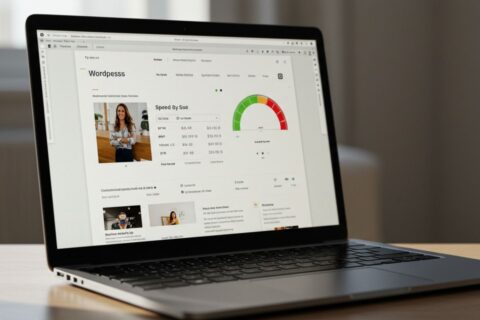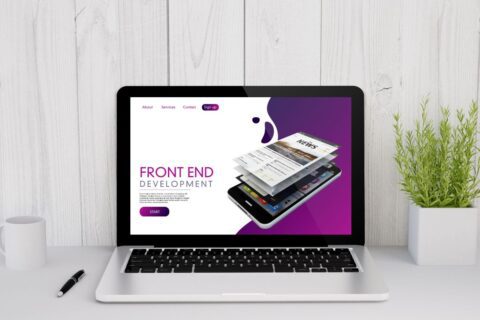Take out a moment and imagine this, a potential homebuyer lands on your website, scrolls for a few seconds, and then… clicks away. Why? It’s not because they aren’t ready to buy, it’s because your website didn’t guide them, engage them, or earn their trust. In the real estate market, first impressions can make or break a sale. That’s why having a smart, user-friendly website design for a real estate company is more important than ever. Whether you’re an agent, broker, or developer, your real estate website design should do more than list properties; it should convert visitors into clients. Let’s explore the features that make that happen.
Why Website Design Matters in Real Estate?
In a world where over 97% of homebuyers begin their search online (National Association of Realtors), your website isn’t just a digital brochure — it’s your most powerful sales tool. A professional website design for real estate company can set you apart in a crowded market by creating a seamless, trust-building experience from the very first click.
According to a Stanford University study, 75% of users judge a company’s credibility based on its website design. That means outdated layouts, slow load times, or poor navigation can instantly turn potential buyers away — no matter how great your listings are.
Investing in real estate web design services ensures your site not only looks good but functions smoothly across all devices. Features like high-resolution property photos, interactive maps, mobile responsiveness, and quick-loading pages all contribute to higher engagement and more inquiries.
Moreover, smart real estate website features — like live chat, advanced search filters, and virtual tours — aren’t just nice to have; they’ve become must-haves. These elements help buyers make decisions faster, increasing the chance they’ll reach out or book a viewing. Simply put, the right web design doesn’t just attract visitors — it converts them into clients.
Essential Website Features That Drive Conversions
A beautiful design alone isn’t enough — your real estate website must function as a conversion machine. The most effective platforms are built with the user journey in mind, guiding visitors from browsing to booking with ease. Below are the must-have real estate website features that do just that.
High-Quality Property Listings with Smart Filters
If your listings aren’t easy to browse, users will leave fast. That’s why your site should offer advanced filters—like location, price range, property type, and number of bedrooms—so users can quickly find what they want. Pair that with HD images, 360° virtual tours, and video walkthroughs, and you’re offering more than just listings — you’re delivering a digital open house.
Contact Best Website Developers in Canada
Mobile-Responsive & Fast-Loading Design
Over 60% of property searches happen on smartphones, so your website must be responsive on all screen sizes. A sluggish site not only drives users away but also affects your SEO rankings. By aligning with Google’s Core Web Vitals, your real estate website development becomes both user-friendly and search-friendly — keeping visitors engaged instead of frustrated.
Integrated Map Search Functionality
Today’s buyers want to see properties in context — not just read about them. With integrated tools like Google Maps or custom mapping, users can explore listings based on neighbourhoods, schools, or commute times. This visual browsing method enhances usability and builds buyer confidence.
Lead Capture Forms and Clear CTAs
Every high-performing website design for real estate company includes strategically placed call-to-action buttons like “Book a Viewing,” “Request Info,” or “Get in Touch.” When paired with smart pop-up forms and sticky contact buttons, these elements prompt action without interrupting the user experience. Integration with your CRM also ensures no lead falls through the cracks.
Client Testimonials and Success Stories
Trust matters in real estate. Adding client reviews, before-and-after stories, or video testimonials adds powerful social proof. Visitors feel more confident when they see others have had positive experiences — especially in high-stakes transactions like buying or selling a home.
Live Chat or AI Chatbot
Questions can arise anytime — and if no one’s there to answer, your lead may disappear. A live chat feature or AI-powered chatbot keeps communication flowing 24/7. Not only does it provide instant answers, but it also helps pre-qualify leads and direct them to the right services or agents.
SEO-Optimized Content and Local Pages
The foundation of lasting visibility lies in search engine optimization. Build out city-specific or neighborhood landing pages, and regularly update your site with blogs, market updates, and local insights. These efforts help drive organic traffic and position you as a local expert — a key goal in real estate website development.
Together, these features don’t just enhance aesthetics — they drive performance, boost credibility, and most importantly, convert visitors into clients.
Design Tips to Build Trust and Drive Action
Great website design for real estate company isn’t just about aesthetics — it’s about building trust from the moment a visitor lands on the page. These design strategies help create a credible, user-friendly experience that encourages action.
Use Clean, Professional Layouts
Cluttered websites confuse users. A clean, modern design with ample white space, grid-based layouts, and readable fonts helps visitors feel calm, focused, and in control. When your design looks professional, your business does too. It’s one of the most subtle yet powerful real estate website features that improves user experience and trust.
Also Read: Minimalistic Web Design
Add Certifications and Licenses
Buyers and sellers want assurance that they’re working with credible professionals. Displaying brokerage logos, MLS affiliations, and certifications like REALTOR® or local real estate board memberships builds trust fast. Think of it as putting your credentials front and center — it reassures visitors they’re in good hands.
Highlight Agent Profiles
People connect with people, not just property listings. Including agent bios with photos, years of experience, specialties, and contact details helps humanize your brand. Well-crafted profiles show that there’s a dedicated expert behind every interaction — a valuable element in any effective real estate web design services package.
Common Mistakes in Real Estate Web Design
Even the most attractive site can fall flat if it lacks the essentials. Here are some of the most common pitfalls in real estate website design:
- Outdated Design or Poor Mobile Experience: With most users browsing on phones, a clunky or non-responsive site can cost you leads. Mobile-first design isn’t optional anymore.
- No Clear Calls-to-Action (CTAs): Without clear buttons like “Schedule a Viewing” or “Get in Touch,” visitors don’t know what to do next — and often leave.
- Too Much Clutter or Difficult Navigation: Overloaded menus, pop-ups, or unorganized layouts confuse users. Simplicity helps guide users to the listings or contact forms they need most.
Fixing these issues is often the first step in leveling up your real estate website development strategy.
Also Read: AI tools for website speed optimization
Get A Website Designed That Converts
Real Estate Website Design Trends in 2025
The digital space is constantly evolving — and so are buyer expectations. If you’re investing in real estate web design services this year, keep these innovative trends in mind:
- AI-Powered Property Recommendations: Think of Netflix, but for homes. AI tools now suggest listings based on user behavior, location, and preferences — making browsing smarter and more personalized.
- Interactive Neighborhood Guides: Buyers want more than just a home; they want a lifestyle. Embedded maps, school ratings, walk scores, and local amenities help users visualize life in the area.
- Video-First Home Listings: Short-form videos, drone footage, and agent-led walkthroughs are becoming the new standard. They boost engagement and give users a real feel of the property — all without leaving the page.
By staying updated with these trends and avoiding common mistakes, your real estate website design won’t just look good — it’ll work hard to convert leads, build trust, and grow your business.
FAQs
Q1: What makes a real estate website user-friendly?
A clean layout, fast loading times, mobile responsiveness, and intuitive navigation help users quickly find what they’re looking for.
Q2: How can I increase leads through my real estate website?
Use strong CTAs, lead forms, live chat, and valuable content like buying guides and neighborhood profiles.
Q3: Is it necessary to include virtual tours and videos?
Yes, they increase engagement and help users visualize properties better—leading to higher conversion rates.
Q4: How often should I update my real estate website content?
Update listings in real-time, blog monthly, and audit the site every 3–6 months to stay relevant.







